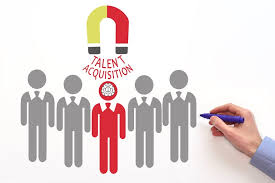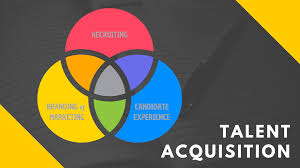Unveiling Top Talent Acquisition Websites
Best Talent Acquisition Websites- In the ever-evolving world of recruitment, the term “talent acquisition” has emerged as the new buzzword. No longer just about filling positions, talent acquisition signifies a strategic approach to identifying, attracting, and retaining top talent. In this article, we’ll explore the realm of talent acquisition websites, offering insights into the best platforms and effective strategies to streamline your hiring process. With the right talent acquisition strategy in place, hiring the right personnel becomes not just easier, but faster and more effective.

Table of Contents
- LinkedIn: The quintessential professional networking platform, LinkedIn reigns supreme in the realm of talent acquisition. With its vast network of professionals spanning various industries, LinkedIn offers unparalleled access to top talent. Leveraging its advanced search filters and interactive features, recruiters can identify and engage with potential candidates effectively.
- Indeed: As one of the largest job search engines globally, Indeed provides a treasure trove of opportunities for recruiters and job seekers alike. Its user-friendly interface and comprehensive job listings make it a go-to platform for talent acquisition professionals. By optimizing job postings and leveraging sponsored listings, recruiters can enhance their visibility and attract quality candidates.
- Glassdoor: Beyond job listings, Glassdoor offers invaluable insights into company culture and employer reputation. Its employer branding features enable businesses to showcase their values and attract candidates who align with their ethos. Additionally, Glassdoor’s review database provides transparency and authenticity, helping candidates make informed decisions about potential employers.
- Monster: With a presence in over 40 countries, Monster remains a stalwart in the realm of online recruitment. Its extensive database of job postings and resumes serves as a goldmine for recruiters seeking top talent. By utilizing Monster’s advanced search filters and applicant tracking system, recruiters can streamline their hiring process and identify the best-fit candidates efficiently.
- CareerBuilder: Since its inception, CareerBuilder has been synonymous with online recruitment excellence. Offering a suite of recruitment solutions, including job postings and resume database access, CareerBuilder empowers recruiters to find the right talent quickly. Its AI-powered hiring tools and predictive analytics provide valuable insights, enabling businesses to make data-driven hiring decisions.
Defining Talent Acquisition
Talent acquisition represents a strategic approach to acquiring and managing talent, distinct from traditional recruitment methods focused solely on filling vacant positions. Unlike recruitment, which tends to be reactive and transactional, talent acquisition adopts a proactive and long-term perspective, aligning recruitment efforts with organizational goals and culture. It involves forecasting future talent needs, building robust talent pipelines, and nurturing relationships with potential candidates to ensure a continuous supply of qualified talent.
Significance of Talent Acquisition
- Strategic Alignment: Talent acquisition aligns recruitment efforts with organizational objectives, ensuring that the workforce composition supports business growth and sustainability.
- Competitive Advantage: By attracting top talent, organizations gain a competitive edge, driving innovation, productivity, and profitability.
- Employer Branding: Talent acquisition contributes to shaping the employer brand, influencing how the organization is perceived by potential candidates, and enhancing its reputation as an employer of choice.
- Talent Retention: A strategic talent acquisition approach not only focuses on attracting talent but also on retaining it through effective onboarding, development, and engagement initiatives.
Understanding Talent Acquisition Strategy
Talent acquisition strategy encompasses the systematic approach that organizations undertake to identify, attract, assess, and onboard the best-suited candidates for their workforce needs. Unlike traditional recruitment methods, which focus solely on filling immediate vacancies, talent acquisition strategy adopts a proactive, long-term approach to talent management. It involves aligning recruitment efforts with overarching business objectives, fostering employer branding, and nurturing talent pipelines to ensure a continuous supply of qualified candidates.

Importance of a Strategic Talent Acquisition Approach
- Competitive Advantage: In today’s talent-driven economy, businesses that excel in attracting top talent gain a competitive edge over their rivals. A well-defined talent acquisition strategy enables organizations to identify and secure high-caliber professionals who can drive innovation, productivity, and profitability.
- Enhanced Employer Branding: A strategic talent acquisition approach not only helps attract top talent but also strengthens the organization’s employer brand. By showcasing a compelling employer value proposition (EVP) and providing a positive candidate experience, businesses can differentiate themselves as employers of choice in the eyes of potential candidates.
- Long-Term Success: Building a talented workforce isn’t just about filling current vacancies; it’s about laying the foundation for sustained growth and success. A proactive talent acquisition strategy ensures that businesses have access to the right talent at the right time, mitigating the risks associated with skill gaps and turnover.
Crafting an Effective Talent Acquisition Strategy
- Define Your Objectives: Begin by clarifying your hiring goals and aligning them with your business objectives. Whether you’re expanding your team or filling critical roles, having a clear understanding of your recruitment needs is essential.
- Identify Your Target Audience: Determine the demographics, skills, and attributes of your ideal candidates. By creating candidate personas, you can tailor your recruitment efforts and messaging to resonate with your target audience effectively.
- Utilize Multiple Channels: Don’t rely solely on one talent acquisition platform. Instead, diversify your approach by leveraging a mix of online job boards, social media, networking events, and employee referrals to reach a broader pool of candidates.
- Enhance Your Employer Brand: Invest in showcasing your company culture, values, and employee benefits to attract top talent. Whether through compelling job descriptions, employer branding initiatives, or employee testimonials, highlight what sets your organization apart as an employer of choice.
- Streamline Your Recruitment Process: Leverage technology, such as applicant tracking systems (ATS) and recruitment software, to automate repetitive tasks and streamline your hiring process. By eliminating bottlenecks and inefficiencies, you can accelerate time-to-hire and secure top talent before your competitors.
Best Qualities of Talent Acquisition Recruiter
The role of a talent acquisition recruiter is pivotal in shaping an organization’s success by ensuring it attracts and retains top talent. A successful talent acquisition recruiter possesses a unique blend of skills, qualities, and characteristics that enable them to excel in their role. Here are some of the best qualities of a talent acquisition recruiter:

- Strong Communication Skills: Effective communication is paramount in talent acquisition. A recruiter must be able to articulate job requirements clearly, engage with candidates professionally, and build rapport with hiring managers and stakeholders.
- Strategic Thinking: A great recruiter doesn’t just fill roles; they contribute to the organization’s long-term success by aligning recruitment efforts with business objectives. Strategic thinking involves anticipating future talent needs, identifying emerging trends, and implementing proactive talent acquisition strategies.
- Relationship Building: Building and maintaining relationships is at the heart of talent acquisition. Recruiters must cultivate strong connections with candidates, hiring managers, and external partners to foster trust and collaboration throughout the recruitment process.
- Empathy and Emotional Intelligence: Understanding the needs, motivations, and emotions of candidates is essential for effective talent acquisition. Recruiters with high emotional intelligence can empathize with candidates, address their concerns, and provide support throughout the hiring journey.
- Adaptability: The recruitment landscape is constantly evolving, and successful recruiters must be adaptable to changes in technology, market dynamics, and candidate preferences. They should embrace new tools, methodologies, and best practices to stay ahead in a competitive environment.
- Problem-Solving Skills: Recruitment often involves navigating complex challenges, from sourcing hard-to-find talent to managing competing priorities. A talented recruiter is a skilled problem solver who can identify obstacles, devise creative solutions, and overcome hurdles to achieve recruitment goals.
- Attention to Detail: In recruitment, even the smallest details can make a significant difference. Recruiters must pay close attention to job requirements, candidate qualifications, and administrative tasks to ensure accuracy and compliance throughout the hiring process.
- Data-Driven Decision Making: Analyzing recruitment metrics and data insights enables recruiters to make informed decisions and optimize their strategies for success. A data-driven approach helps identify trends, measure performance, and continuously improve recruitment outcomes.
- Resilience: Recruiting can be a demanding and high-pressure profession, requiring resilience in the face of setbacks and challenges. A resilient recruiter remains steadfast, maintains a positive attitude, and perseveres through obstacles to achieve desired outcomes.
- Continuous Learning Mindset: The recruitment landscape is dynamic, and successful recruiters embrace lifelong learning to stay abreast of industry trends, best practices, and emerging technologies. They seek out opportunities for professional development, attend training programs, and engage in networking to expand their knowledge and skills.
In summary, the best talent acquisition recruiters possess a diverse range of qualities, from strong communication and strategic thinking to empathy, adaptability, and resilience. By embodying these traits and continually refining their skills, recruiters can make a significant impact on their organization’s talent acquisition efforts and contribute to its overall success.
Best Practices for Optimizing Talent Acquisition Strategy
- Data-Driven Decision Making: Leveraging data analytics and recruitment metrics enables organizations to gain insights into the effectiveness of their talent acquisition efforts. By tracking key performance indicators (KPIs) such as time-to-fill, cost-per-hire, and quality-of-hire, businesses can identify areas for improvement and refine their strategies accordingly.
- Continuous Improvement: Talent acquisition is an iterative process that requires continuous learning and adaptation. Regularly reviewing and refining recruitment processes, leveraging feedback from candidates and hiring managers, and staying abreast of industry trends and best practices are essential for staying competitive in talent acquisition.
- Collaboration and Alignment: Effective talent acquisition requires collaboration and alignment between HR, hiring managers, and other stakeholders. Establishing clear communication channels, defining roles and responsibilities, and fostering a culture of collaboration can streamline the recruitment process and ensure a unified approach to talent acquisition.
- Technology Integration: Embracing innovative recruitment technologies, such as applicant tracking systems (ATS), candidate relationship management (CRM) platforms, and AI-powered tools, can enhance efficiency, scalability, and candidate engagement. However, it’s essential to strike a balance between automation and human touch to maintain a personalized candidate experience.
- Employer Brand Advocacy: Empowering employees to become brand advocates can amplify the organization’s employer brand and attract passive candidates. Encouraging employees to share their positive experiences on social media, participate in employer branding initiatives, and refer qualified candidates can significantly expand the talent pool.
Difference Between Talent Acquisition and Recruitment
Talent acquisition and recruitment are often used interchangeably, but they represent distinct approaches to acquiring talent for an organization. Here’s a breakdown of the key differences between talent acquisition and recruitment:
- Scope and Focus:
- Recruitment typically refers to the process of filling specific job vacancies or positions within an organization. It tends to be more transactional and reactive, focusing on immediate hiring needs.
- Talent acquisition, on the other hand, encompasses a broader and more strategic approach to acquiring talent. It involves proactively identifying, attracting, and retaining skilled individuals to meet current and future organizational needs. Talent acquisition considers long-term workforce planning and aligns recruitment efforts with broader business objectives.
- Timeframe:
- Recruitment is often characterized by short-term goals and immediate hiring needs. Recruiters focus on filling vacant positions promptly, often in response to urgent demands from hiring managers.
- Talent acquisition takes a more proactive and forward-looking approach, considering the organization’s long-term talent needs. It involves building talent pipelines, nurturing relationships with potential candidates, and anticipating future staffing requirements.
- Relationship Building:
- Recruitment typically involves transactional interactions between recruiters and candidates, primarily focused on filling specific job openings.
- Talent acquisition emphasizes relationship building and engagement with candidates, even when there are no immediate job openings. Recruiters work to establish connections with potential candidates, whether through networking, employer branding, or talent community engagement.
- Employer Branding:
- Recruitment may involve limited employer branding efforts focused on attracting candidates to specific job opportunities.
- Talent acquisition places greater emphasis on employer branding as a means to attract and engage top talent. Recruiters work to cultivate a positive employer brand reputation, showcasing the organization’s culture, values, and opportunities for career growth.
- Strategic Alignment:
- Recruitment activities may not always align closely with broader organizational goals and objectives. Recruiters may focus primarily on filling immediate vacancies without considering long-term workforce planning.
- Talent acquisition is strategically aligned with organizational objectives, taking into account the company’s growth plans, talent needs, and competitive landscape. Recruiters collaborate closely with stakeholders to ensure that recruitment efforts support the organization’s overall strategic direction.
In summary, while both recruitment and talent acquisition are essential components of workforce management, they differ in terms of scope, focus, timeframe, relationship building, employer branding, and strategic alignment. Talent acquisition represents a more proactive and strategic approach to acquiring talent, whereas recruitment tends to be more reactive and focused on immediate hiring needs.
Conclusion
In today’s dynamic business environment, talent acquisition has evolved from a transactional process to a strategic imperative. By adopting a proactive, holistic approach to talent acquisition strategy, businesses can position themselves for long-term success and competitive advantage. From talent needs analysis to employer branding, sourcing, selection, and onboarding, every aspect of the recruitment process plays a crucial role in shaping the organization’s talent landscape. By embracing best practices, leveraging technology, and fostering a culture of continuous improvement, businesses can build a talented workforce that drives innovation, growth, and prosperity.

